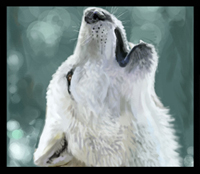Tracking
Tracking is a skill used to follow a quarry or prey by following the tracks and markings they leave. These tracks can range from footprints, campsite remains, disturbed bushes and even excrement. This is a skill normally used by hunters to follow their prey through the wilderness. However, tracking does not remain in the realm of hunting animals, it can be applied to tracking humans and other sentient creatures though this tends to be almost impossible in cities such as Syliras.
Learning the tracking skill teaches one a lot one’s self. It teaches its students the importance of looking out for details. It enforces the need to focus on specific elements of the world around them and having the commitment to keep going. Tracking is a challenging skill that is not entirely as simple as one would think. Generally, Kelvics benefit far better from tracking than any other race, especially predatory ones as they are able to use their improved senses to better track their prey.
Prerequisites and Related Skills
Wilderness Survival
Hunting
Interrogation (Urban Environments)
Novice (1-25)
A Novice has barely begun to track and does not do so very often. They spend much of their time learning the theory behind tracking and generally the feel the need to accompany a more experienced tracker but it is not required. A novice tracker starts simply learning how to identify tracks. Through this identification, they can make an assumption about the general size of an animal. They can make basic interpretations about the tracks such as direction and can vaguely distinguish between tracks made at speed and those at a slower pace.
Trackers at this level are just learning to become aware of the nature and terrain around them. They would spend a lot of time simply observing the land for signs of tracks. They can generally only spot tracks with clear patterns. They tend to only be able to see these in soft mud, wet sand and firm snow conditions. It is extremely easy to fool a novice with false tracks as they are simply happy to find something to track. Tracking humans and other such creatures is generally far out of their reach.
Competent (26-50)
Competent trackers tend to venture out on their own more often. A competent tracker is comfortable with the basics of tracking. They are able to identify tracks much quicker and can begin to make more assumptions about their quarry with greater accuracy. They can begin to tell height and weight and can better gauge the speed at which it was moving. In certain animals tracks such as bears and cats, they can also tell the sex. They can also begin to tell what an animal was doing such as feeding through observation of the surrounding area. A tracker at this level is also able to spot markings on trees indicated a creature has climbed it, these could be scarped or broken bark, broken lower branches. Tracking while up the tree is slightly more difficult.
They can now begin to spot signs made by their quarry. Maybe these are markings on a tree left by the antlers of a stag. They are also able to track over more difficult terrain such as soft clay and damper ground that is not necessarily mud. They can begin to track humans through footprints but tend to loose the trail easily. Tricking competent trackers becomes a lot harder than simply erasing footprints however as they tend to be able to spot the ground shifted oddly.
Generally, Urban tracking is a lot more difficult than through the wilds. While the skills used are virtually the same, one must change their techniques to better suit the environment around. In cities, tracks can become heavily congested with traffic that passes by day in and day out. Asking questions is usually the best way but a competent tracker will struggle.
Expert (51-75)
Experts in the tracking profession are generally sought out by lesser hunters and even authorities for helping in tracking their own quarries. They enjoy being outdoors are it is like being in a different world to them. To their trained eyes, they can spot movements of animals and herds, signs left by creatures that lesser people would not even notice. An expert tracker is less intrusive on the world around them and is more alert to ebb and flow around them. They are now confident in picking up trails left by animals and humans and are able to make accurate assumptions about the creature and any conditions they might possess. An expert has no trouble both spotting where animals climb trees but also tracking them through the branches themselves though a skill point in climbing would likely help this endeavour.
An expert tracker is able to track their foes through grassland. They can pick up tracks through the movement of leaves, pine needles and hard packed ground. They can see patterns in the landscape to judge animals movements such as disturbed plants and flowers. They are now able to fully track humans in the same way they would animals and can begin to tell the age of tracks. An expert is also able to look at several different tracks and divine what happened in the area. Be it a wolf and a deer wrestling or even a fight between bandits and Syliras Patrol.
Urban tracking becomes easier now. Especially with the help of enhanced senses. An expert has a much easier time of spotting telltale signs of a rushed escape. They also better know what questions to ask and who to ask.
Master (76-100)
A Master Tracker is an unrelenting force when it comes to following their prey. A master is as much part of the nature around him as smallest squirrel or the mightiest jungle cat. An expert tracker can tell apart two creatures of the same species by simple footprints. They can spot even the slightest movement in the dirt. They can even turn their impressive skills to tracking on over stone ground, though even this is hard for them and can be vague at times.
It is almost utterly impossible to fool a master tracker with false tracks, even if you yourself are a master tracker. They are highly sought out individuals who are at home in the wilds where the world around them speaks to them.
- Getting Started
- Help
- Master Lists
- Useful Links
- Features
Tracking Wiki
(This is a thread from Mizahar's fantasy roleplay forums. Why don't you register today? This message is not shown when you are logged in. Come roleplay with us, it's fun!)Moderator: Scribes
21 posts • Page 1 of 3 • 1, 2, 3
Tracking Wiki
Last edited by Gromhir on March 1st, 2010, 5:22 pm, edited 7 times in total.
The world can make you think that everything matters. But all that really matters is that the sun rises and you enjoy what you're given.
-

Gromhir - Resident Big Softy
- Posts: 200
- Words: 90232
- Joined roleplay: September 25th, 2009, 6:23 pm
- Location: Drinking creepy tea with Ninja's in your wardrobe
- Blog: View Blog (1)
- Race: Kelvic
- Character sheet
- Scrapbook
- Medals: 2
-


-

Kadurro - Snarky Conman
- Posts: 73
- Words: 14187
- Joined roleplay: January 2nd, 2010, 10:45 am
- Race: Human, Vantha
- Character sheet
- Medals: 1
-

-

Gossamer - Words reveal soul.
- Posts: 21150
- Words: 6362535
- Joined roleplay: March 23rd, 2009, 4:40 pm
- Location: Founder
- Blog: View Blog (24)
- Race: Staff account
- Office
- Scrapbook
- Plotnotes
- Medals: 11
-


-


-


-


-


-

Stitch - Blind Man
- Posts: 859
- Words: 498882
- Joined roleplay: December 11th, 2009, 8:48 pm
- Location: Syliras
- Race: Human
- Character sheet
- Storyteller secrets
- Scrapbook
- Medals: 12
-


-


-


-


-

Re: Tracking Wiki
The world can make you think that everything matters. But all that really matters is that the sun rises and you enjoy what you're given.
-

Gromhir - Resident Big Softy
- Posts: 200
- Words: 90232
- Joined roleplay: September 25th, 2009, 6:23 pm
- Location: Drinking creepy tea with Ninja's in your wardrobe
- Blog: View Blog (1)
- Race: Kelvic
- Character sheet
- Scrapbook
- Medals: 2
-


Re: Tracking Wiki
The world can make you think that everything matters. But all that really matters is that the sun rises and you enjoy what you're given.
-

Gromhir - Resident Big Softy
- Posts: 200
- Words: 90232
- Joined roleplay: September 25th, 2009, 6:23 pm
- Location: Drinking creepy tea with Ninja's in your wardrobe
- Blog: View Blog (1)
- Race: Kelvic
- Character sheet
- Scrapbook
- Medals: 2
-


-

Gossamer - Words reveal soul.
- Posts: 21150
- Words: 6362535
- Joined roleplay: March 23rd, 2009, 4:40 pm
- Location: Founder
- Blog: View Blog (24)
- Race: Staff account
- Office
- Scrapbook
- Plotnotes
- Medals: 11
-


-


-


-


-


Re: Tracking Wiki
The world can make you think that everything matters. But all that really matters is that the sun rises and you enjoy what you're given.
-

Gromhir - Resident Big Softy
- Posts: 200
- Words: 90232
- Joined roleplay: September 25th, 2009, 6:23 pm
- Location: Drinking creepy tea with Ninja's in your wardrobe
- Blog: View Blog (1)
- Race: Kelvic
- Character sheet
- Scrapbook
- Medals: 2
-


-

Cayenne - Jungle Queen
- Posts: 1839
- Words: 440090
- Joined roleplay: March 26th, 2009, 3:48 pm
- Location: Depths of Falyndar
- Blog: View Blog (5)
- Race: Staff account
- Office
- Scrapbook
- Medals: 4
-


-

Re: Tracking Wiki
The world can make you think that everything matters. But all that really matters is that the sun rises and you enjoy what you're given.
-

Gromhir - Resident Big Softy
- Posts: 200
- Words: 90232
- Joined roleplay: September 25th, 2009, 6:23 pm
- Location: Drinking creepy tea with Ninja's in your wardrobe
- Blog: View Blog (1)
- Race: Kelvic
- Character sheet
- Scrapbook
- Medals: 2
-


21 posts • Page 1 of 3 • 1, 2, 3
Who is online
Users browsing this forum: No registered users and 0 guests

